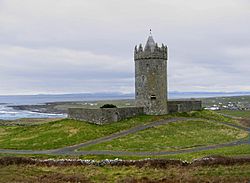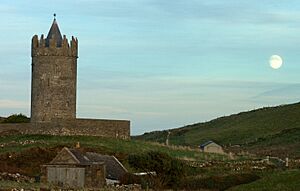Doonagore Castle facts for kids
Quick facts for kids Doonagore Castle |
|
|---|---|

Doonagore Castle, overlooking Doolin and the Atlantic Ocean
|
|
| General information | |
| Location | Doolin, County Clare, Ireland |
| Coordinates | 53°00′12″N 9°23′14″W / 53.00327°N 9.38713°W |
| Completed | 16th century |
Doonagore Castle is an old castle from the 1500s. It has a round tower and a small wall around it. You can find it about 1 kilometer south of Doolin, a village in County Clare, Ireland.
The castle's name, Doonagore, might come from an Irish phrase, Dún na Gabhair. This means "the fort of the rounded hills" or "the fort of the goats." Today, Doonagore Castle is a private holiday home, so people cannot visit inside.
Contents
Discovering Doonagore Castle's Location
Doonagore Castle sits on a hill. From there, you can see Doolin Point and the Atlantic Ocean. The castle, along with a tall radio mast nearby, helps boats find their way to Doolin Pier. It is located in a place called Doonagore, in the area of Killilagh, County Clare. Some people also think of it as being in the famous rocky area known as the Burren.
The Story of Doonagore Castle
A very old fort, called a ringfort, was once on this spot. Then, a castle was built there by Tadhg MacTurlough MacCon O'Connor in the 1300s.
The castle you see today was likely built in the mid-1500s. Unlike many castles in this area, which are made of limestone, Doonagore Castle was built using sandstone. This stone came from a place called Trá Leachain, or Flaggy Beach, about 2 kilometers away.
Who Owned Doonagore Castle?
- In 1570, Sir Donald O'Brien owned the castle. He was part of the powerful O'Brien dynasty.
- By 1582, Brian MacCahill O'Connor lived there.
- In 1583, much of the land around the castle was given to the King or Queen of England. It was then given to Turlough O'Brien.
- Soon after, the MacClancy family took over Doonagore. They were important lawyers for the O'Briens.
The Spanish Armada Shipwreck
In September 1588, a ship from the Spanish Armada was wrecked near the castle. The Spanish Armada was a huge fleet of ships sent by Spain to invade England. Many sailors survived the shipwreck. Sadly, about 170 survivors were captured by the local sheriff, Boetius Clancy. They were taken to Doonagore Castle or a nearby hill called Cnocán an Crochaire, which means "Hangman's Hill."
Later Years and Restoration
After a big rebellion in Ireland in 1641, Doonagore Castle was given to John Sarsfield. This happened during a time when land was being redistributed by the English government.
Later, in the late 1600s or early 1700s, the Gore family owned the castle. They fixed it up in the early 1800s. However, by 1837, the castle was falling apart again.
In the 1970s, an architect named Percy Le Clerc helped restore the castle. It was bought by an Irish-American named John C. Gorman. His family still owns the castle today.
What Doonagore Castle Looks Like
Doonagore is one of only three round castles in the Burren area. The other two are Newtown Castle and Faunarooska. Most of Doonagore is made of sandstone. However, some of its pretty decorations are carved from limestone.
The castle tower originally had four floors, plus a cellar. There was a special arched ceiling, called a beehive vault, between the first and second floors. The main door was protected by a machicolation. This was a hole in the floor above the entrance, used to drop things on attackers. A strong wall, called a bawn, surrounded the tower.
Visiting Doonagore Castle Today
Doonagore Castle is a private holiday home. This means it is not open for the public to visit.
See also
 In Spanish: Castillo de Doonagore para niños
In Spanish: Castillo de Doonagore para niños


